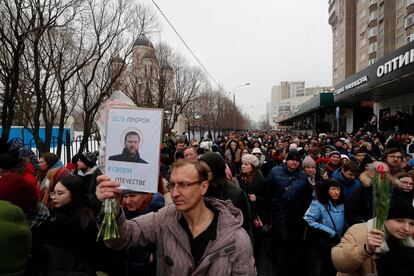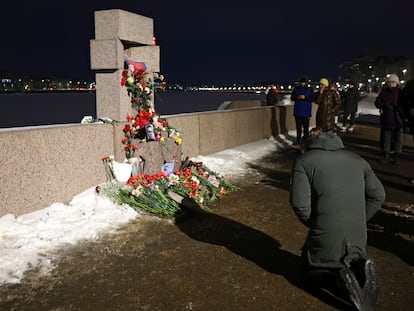Putin foe Alexei Navalny is buried in Moscow as thousands attend under heavy police presence
Western diplomats, including U.S. Ambassador Lynn Tracy, were among those who attended, along with presidential hopefuls Boris Nadezhdin and Yekaterina Duntsova

Under a heavy police presence, thousands of people bade farewell Friday to Alexei Navalny at his funeral in Moscow after his still-unexplained death two weeks ago in an Arctic penal colony.
The service followed a battle with authorities over the release of the body of President Vladimir Putin’s fiercest critic. His supporters said several churches in Moscow refused to hold the funeral for the man who crusaded against official corruption and organized big protests. Many Western leaders blamed the death on the Russian leader, an accusation the Kremlin angrily rejected.
Navalny’s team eventually got permission from the Church of the Icon of the Mother of God Soothe My Sorrows, which was encircled by crowd-control barriers on Friday.
As his coffin was removed from the hearse and taken inside the church, the crowd waiting outside broke into respectful applause and then chanted: “Navalny! Navalny!” Some also shouted, “You weren’t afraid, neither are we!” and later “No to war!”
Western diplomats, including U.S. Ambassador Lynn Tracy, were among those who attended, along with presidential hopefuls Boris Nadezhdin and Yekaterina Duntsova. Both wanted to run against Putin in the upcoming presidential elections and opposed his war in Ukraine; neither was allowed on the ballot.
A photo from inside the church showed an open casket with Navalny’s body covered with red and white flowers, and his mother sitting beside it holding a candle.
Navalny’s father was also present, but it wasn’t clear who else in his family attended. His widow, Yulia Navalnaya, just two days ago addressed the European Parliament in Strasbourg, France; his daughter is a student at the Stanford University, and the whereabouts of his son are unknown.
The politician’s closest associates have left Russia under pressure and watched the funeral, which was streamed live on his YouTube channel, from abroad.
Kremlin spokesman Dmitry Peskov urged those gathering in Moscow and other places not to break the law, saying any “unauthorized (mass) gatherings” are violations.
“Those people who follow what is happening, it is of course obvious to them that this man is a hero of our country, whom we will not forget,” said Nadezhda Ivanova, a Kaliningrad resident who was outside the church with other supporters. “What was done to him is incredibly difficult to accept and get through it.”
After the short funeral, a crowd of thousands marched from the church to the nearby Borisovskoye Cemetery, where the police were also out in force for the burial.
With the casket open, Navalny’s parents and others stroked and kissed his body. Meanwhile, a large crowd of supporters gathered at the gates of the cemetery, chanting: “Let us in to say say goodbye!”
The coffin was then lowered into the ground, allies said.
Navalny’s mother, Lyudmila Navalnaya, spent eight days trying to get authorities to release the body following his Feb. 16 death at Penal Colony No. 3 in the town of Kharp, in the Yamalo-Nenets region about 1,900 kilometers (1,200 miles) northeast of Moscow.
Even on Friday itself, the morgue where the body was being held delayed its release, according to Ivan Zhdanov, Navalny’s close ally and director of his Anti-Corruption Foundation.
Authorities originally said they couldn’t turn over the body because they needed to conduct post-mortem tests. Navalnaya made a video appeal to Putin to release it so she could bury her son with dignity.
At least one funeral director said he had been “forbidden” to work with Navalny’s supporters, his spokeswoman Kira Yarmysh said on social media. They also struggled to find a hearse.
“Unknown people are calling up people and threatening them not to take Alexei’s body anywhere,” Yarmysh said Thursday.
Russian authorities still haven’t announced the cause of death for Navalny, who was 47.
Navalny had been jailed since January 2021, when he returned to Moscow to face certain arrest after recuperating in Germany from nerve agent poisoning he blamed on the Kremlin.
His Foundation for Fighting Corruption and his regional offices were designated as “extremist organizations” by the Russian government that same year.
His widow accused Putin and Moscow Mayor Sergei Sobyanin of trying to block a public funeral.
“We don’t want any special treatment — just to give people the opportunity to say farewell to Alexei in a normal way,” Yulia Navalnaya wrote on X, the platform formerly known as Twitter. In a speech to European lawmakers on Wednesday, she also expressed fears that police might interfere with the gathering or would “arrest those who have come to say goodbye to my husband.”
Moscow authorities refused permission for a separate memorial event for Navalny and slain opposition leader Boris Nemtsov on Friday, citing Covid-19 restrictions, according to politician Yekaterina Duntsova said. Nemtsov, a 55-year-old former deputy prime minister, was shot to death as he walked on a bridge adjacent to the Kremlin on the night of Feb. 27, 2015.
Yarmysh also urged Navalny’s supporters around the world to lay flowers in his honor Friday.
“Everyone who knew Alexei says what a cheerful, courageous and honest person he was,” Yarmysh said Thursday. “But the greater truth is that even if you never met Alexei, you knew what he was like, too. You shared his investigations, you went to rallies with him, you read his posts from prison. His example showed many people what to do when even when things were scary and difficult.”
Sign up for our weekly newsletter to get more English-language news coverage from EL PAÍS USA Edition
Tu suscripción se está usando en otro dispositivo
¿Quieres añadir otro usuario a tu suscripción?
Si continúas leyendo en este dispositivo, no se podrá leer en el otro.
FlechaTu suscripción se está usando en otro dispositivo y solo puedes acceder a EL PAÍS desde un dispositivo a la vez.
Si quieres compartir tu cuenta, cambia tu suscripción a la modalidad Premium, así podrás añadir otro usuario. Cada uno accederá con su propia cuenta de email, lo que os permitirá personalizar vuestra experiencia en EL PAÍS.
¿Tienes una suscripción de empresa? Accede aquí para contratar más cuentas.
En el caso de no saber quién está usando tu cuenta, te recomendamos cambiar tu contraseña aquí.
Si decides continuar compartiendo tu cuenta, este mensaje se mostrará en tu dispositivo y en el de la otra persona que está usando tu cuenta de forma indefinida, afectando a tu experiencia de lectura. Puedes consultar aquí los términos y condiciones de la suscripción digital.
More information
Archived In
Últimas noticias
Most viewed
- Sinaloa Cartel war is taking its toll on Los Chapitos
- Oona Chaplin: ‘I told James Cameron that I was living in a treehouse and starting a permaculture project with a friend’
- Reinhard Genzel, Nobel laureate in physics: ‘One-minute videos will never give you the truth’
- Why the price of coffee has skyrocketed: from Brazilian plantations to specialty coffee houses
- Silver prices are going crazy: This is what’s fueling the rally









































